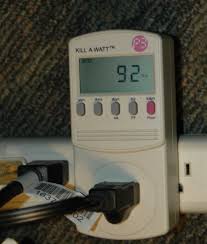I saw this mentioned on an environmental website the other day, and thought it was pretty cool, especially since I'm a former alum.
"According to a University of Iowa video, burning oat hulls - instead of just coal - saves about $1 million per year for the school. It gets the oat hulls from a Quaker Oats facility, which is just a short distance away in Cedar Rapids, IA. By 2010, the university plans to reduce its energy consumption by 10 percent and use renewable sources to generate 15 percent of all energy on campus."
There is also a short video developed by the University of Iowa to describe the "oat hulls" used to generate power.
Sunday, February 22, 2009
Sunday, February 15, 2009
Kill-a-Watt Electricity Usage Monitor
We bought the Kill-a-Watt, in order to help us figure out where we were spending most of our money in electricity. We were hoping it would also help us figure out whether we had phantom power on some of our devices (using power when not in use).

The device works by simply unplugging the 110-volt device from the wall, plugging in the Kill-a-Watt into the outlet, then plugging the device into the Kill-a-Watt, and pressing the on button. That simple! It starts to measure the amount of kilowatt hours (KwH) of electricity used, and retains the amount of minutes and hours that it has been plugged in, so you can determine how much is used per hour, per day, etc.

We determined that many of our devices did not have phantom power (good!), and that certain devices are very energy intensive, such as ovens and refrigerators. We turned down the temperature slightly on the fridge, and started using our toaster oven more often, instead of heating the entire oven for items that could fit in the toaster oven.
We would highly recommend this device to anyone looking to reduce their energy usage and electrical bills (which should be everybody!). It is affordable, easy to use, and will pay for itself in no time!

The device works by simply unplugging the 110-volt device from the wall, plugging in the Kill-a-Watt into the outlet, then plugging the device into the Kill-a-Watt, and pressing the on button. That simple! It starts to measure the amount of kilowatt hours (KwH) of electricity used, and retains the amount of minutes and hours that it has been plugged in, so you can determine how much is used per hour, per day, etc.

We determined that many of our devices did not have phantom power (good!), and that certain devices are very energy intensive, such as ovens and refrigerators. We turned down the temperature slightly on the fridge, and started using our toaster oven more often, instead of heating the entire oven for items that could fit in the toaster oven.
We would highly recommend this device to anyone looking to reduce their energy usage and electrical bills (which should be everybody!). It is affordable, easy to use, and will pay for itself in no time!
Saturday, February 7, 2009
"Consumer's Guide to Alternative Energy" DVD
I recently viewed a DVD called "Consumer's Guide to Alternative Energy". This video provides a more thorough explanation of alternative energy and fuels than I've seen any other place.
The video goes through the following alternatives:
» Ethanol
» Solar Power
» BioDiesel
» Wind Generators
» Hybrid & Electric Cars
It also has additional links to resources and websites to learn even more about each one. At the end, it also includes an Energy Efficiency and Conservation module that has tips for reducing your impact, if you aren't looking to invest in any of these options right now.

What I liked best was the unbiased opinion. For each category, it would give the positives and negatives of each, so that people would know what they were getting into (for example, using ethanol-based fuels can reduce your gas efficiency by 25%). Often times, these details are not mentioned, or are not discovered until you get too far into the investigation.
This would be a great video for classrooms, businesses or just for people who want to learn more about the different options out there today. It lasts 34 minutes, but there's quite a bit of information presented, using real people who are already using these options.
The DVD was created by Syndikast, as part of their Future Fuels Series. If you are interested in purchasing it, visit their website at Future Fuels TV.
The video goes through the following alternatives:
» Ethanol
» Solar Power
» BioDiesel
» Wind Generators
» Hybrid & Electric Cars
It also has additional links to resources and websites to learn even more about each one. At the end, it also includes an Energy Efficiency and Conservation module that has tips for reducing your impact, if you aren't looking to invest in any of these options right now.

What I liked best was the unbiased opinion. For each category, it would give the positives and negatives of each, so that people would know what they were getting into (for example, using ethanol-based fuels can reduce your gas efficiency by 25%). Often times, these details are not mentioned, or are not discovered until you get too far into the investigation.
This would be a great video for classrooms, businesses or just for people who want to learn more about the different options out there today. It lasts 34 minutes, but there's quite a bit of information presented, using real people who are already using these options.
The DVD was created by Syndikast, as part of their Future Fuels Series. If you are interested in purchasing it, visit their website at Future Fuels TV.
Subscribe to:
Comments (Atom)



